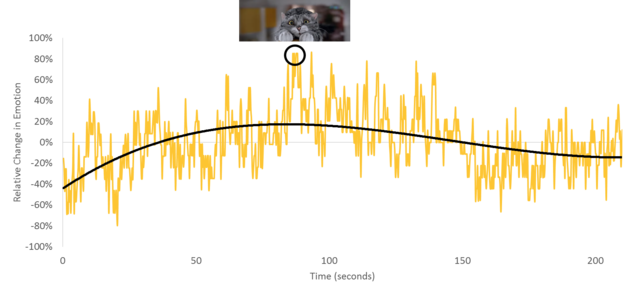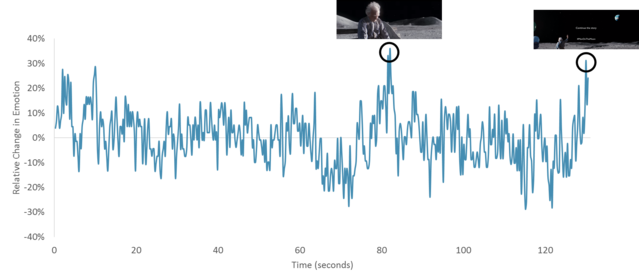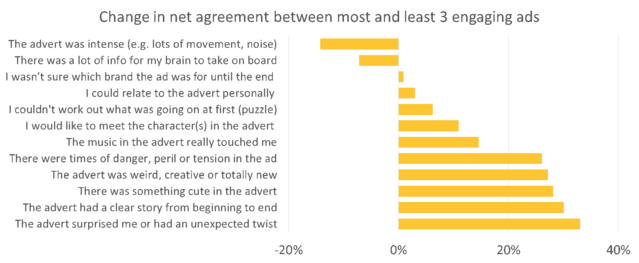Consumer Behavior
John Lewis Lost the Christmas Ad Crown, but Why?
Facial coding shows that Mog is the winner for a number of psychological reasons
Posted December 18, 2015
Every Christmas, John Lewis spends about £7 million on their Christmas advertising - and every Christmas, these adverts seemingly pull on our heart strings and consequently open our purse strings (The Hare and the Bear increased year-on-year sales by 44%, for example).
Indeed, emotion is an incredibly effective strategy for advertising. As one academic paper wrote, “The more emotions dominate over rational messaging, the bigger the business effects. The most effective advertisements of all are those with little or no rational content.”
Of course, other brands have stood up and taken notice. Consequently, British consumers have become the victims of the War of the “Could You Please Pass the 'Roses', Dear” every Christmas, where retailers battle to have the biggest emotional impact on the nation.
While John Lewis has tended to dominate, this year another contender has stepped into the ring – that is, the Sainsbury’s advert featuring the trials and tribulations of Mog the Cat.
According to a recent CityAM article, John Lewis leads British ads with 1,156,223 social media shares, while Sainsbury’s follows closely in second place with 811,939.
But could this just be hype? Might people be sharing the John Lewis advert because it is, simply, ‘the famous John Lewis Christmas advert’? The CityAM article itself, for example, claimed that the Sainsbury’s advert was its own personal favourite.
Importantly, in an age of headphones that can measure your heartbeat, it's possible to definitively find out which Christmas ad tugs at the heartstrings the strongest.
Facial coding provider CrowdEmotion collaborated with ICM to measure people’s emotional responses to six Christmas adverts. This was done by measuring people’s facial expressions (such as furrowed brows or open-mouthed smiles) via their webcam while watching the adverts.
So which advert won this year - John Lewis or Sainsbury’s?
As seen below, Mog the Cat was the winner of both hearts and minds. In other words, more people agreed that they liked it (i.e. consciously or explicitly liked it), but it was also more emotionally engaging. The Man on the Moon was about average, scoring 1% above the Christmas norm for emotional engagement, while Mog the Cat scored 8% above the norm.
So Mog beat The Man on the Moon for both hearts and minds - but why?
The chart below shows which emotions were stronger for which advert.

First and foremost, Mog the Cat produced a massive 151% more puzzlement - or curiosity.
Curiosity is important in advertising because we are innately hard-wired to close gaps in our understanding of the world and solve mysteries. One experiment, for example, increased school children’s homework scores by 19% simply by using a ‘mystery motivator’ - a sealed envelope containing an unknown reward that would be given out on an unknown day.
Similarly, in another study, participants read one of two versions of a crime story, in which uncertainty was either high (i.e. both suspects were equally likely to have committed the crime) or low (i.e. it was clear who the suspect was). Enjoyment of the story was significantly higher when there was mystery about the outcome. Indeed, eight years after The Sopranos ended with a mysterious and unexplained cut to black, commentators are still debating what it might mean.
Moving on, Mog the Cat also produced 13% more happiness - which is likely a good thing since a review of fMRI studies found that humour is the second-strongest emotion (behind fear), and research suggests positive emotions are more effective in ads than negative ones.
However, looking at happiness levels across the duration of the Sainsbury's ad also tells us two more important things.

Firstly, there is a clear three-act narrative structure. It is known that effective stories should have: 1) some introductory exposition; 2) a complication for the protagonist and a climax as the conflict develops; 3) and finally a solution to the conflict and a final denouement, or resolution. The Sainsbury’s ad clearly follows this structure, as shown by the happiness data over time.
One piece of research found that Super Bowl ads which followed this story structure performed significantly better than those which did not.
Secondly, the largest spike in happiness (85% above the ad's average) occurs when the cat loses his grip from the ceiling fan; in fact, Mog induces a lot of engagement. This ties in with what I like to call "Pug Power". Humans are evolutionarily hard-wired to be attentive around babies (or things that look like babies); babies probably would have been eaten or fallen out of trees otherwise! A study supports this theory, showing that pictures of baby animals (as opposed to adult ones) increases scores and time spent playing on an Operation-type game of attentiveness.
Just as Compare the Market’s meerkat increased website traffic by 400%, the McVitie’s Sweeet kittens and puppies increased market share by 26%, and Cravendale’s Cats with Thumbs increased sales by 8%, Mog may have helped Sainsbury’s win the Christmas crown this year - just like John Lewis’ snowmen, hares and bears, and penguins did in previous years.
While Mog the Cat was fun and suspenseful, John Lewis' The Man on the Moon produced 22% more sadness in viewers. Research has shown that what can really drive the success of an advert is arousal, or excitement. On the other hand, sadness is literally depressing, resulting, essentially, in less brain activity, meaning the advert is likely to receive less attention, less memory, and so on.

Finally, The Man on the Moon produced 21% more disgust - while this can be a good thing (for example, it drives how much an urban legend will get shared), it is often an indicator of rejection or disliking, which is ostensibly bad for John Lewis.
Looking at the duration of disgust across the ad gives some clues as to what may be happening; there are two major peaks.

The first peak occurs when the old man is seen sitting depressed and alone on the moon. Generally speaking, people don't like to be reminded of their own mortality, and an ad featuring a sad, old man may make people want to push the ad out of their minds.
The second peak is seen at the end when John Lewis' branding appears. Manipulating feelings of guilt and pathos towards the elderly, in a branded advert, may result in people perceiving the advert as exploitative; when consumers are sceptical or ‘have their back up’, adverts can become less effective.
In summary, John Lewis usually is the outstanding Christmas advert winner every year - but this year, Sainsbury's appears to have stolen the crown with Mog the Cat. This is seemingly thanks to the use of a clear narrative and dramatic suspense, a cute protagonist (i.e. "Pug Power"), and positive emotions.
The importance of these elements is clear in the chart below, showing the change in agreement with statements across the top and bottom half most emotionally engaging ads we tested. The more engaging ads were more likely to have peril and a twist (i.e. curiosity), a clear story, and something new - among other things.

Interestingly, this appears to be the formula John Lewis used in its previous winning adverts - the snowmen-featuring ad The Journey, The Bear and the Hear, and, of course, Monty the Penguin.
The question is - why on earth did they not stick with their winning formula?
A final post-script.
To its credit, John Lewis did produce 40% more surprise (it is indeed a creative and novel advert), which is a very important attribute in advertising. In fact, the John Lewis ad is by no stretch of the imagination a 'bad' advert: it does many things right, including a narrative, a strong use of emotion, and excellent distinctive assets. Compared to most adverts consumers see day-to-day, The Man on the Moon is an absolute winner. The ad might not do as well as previous Christmases, but, still, it will no doubt have a strong sales effect.
However, this year, the fact is that it was pipped to the post by Sainsbury's, who simply created a better ad!




